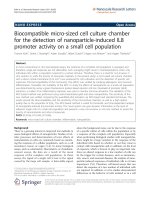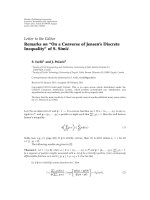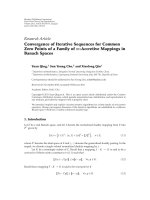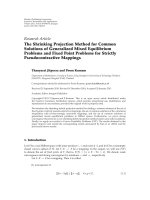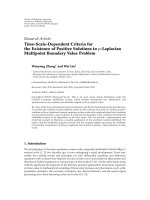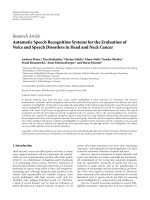Báo cáo hóa học: " ITERATIVE SCHEMES WITH SOME CONTROL CONDITIONS FOR A FAMILY OF FINITE NONEXPANSIVE MAPPINGS IN BANACH SPACES" docx
Bạn đang xem bản rút gọn của tài liệu. Xem và tải ngay bản đầy đủ của tài liệu tại đây (543.42 KB, 11 trang )
ITERATIVE SCHEMES WITH SOME CONTROL
CONDITIONS FOR A FAMILY OF FINITE
NONEXPANSIVE MAPPINGS IN BANACH SPACES
JONG SOO JUNG, YEOL JE CHO, AND R. P. AGARWAL
Received 19 September 2004 and in revised form 8 January 2005
The iterative schemes with some control conditions for a family of finite nonexpansive
mappings are established in a Banach space. The main theorem improves results of Jung
and Kim (also Bauschke). Our results also improve the corresponding results of Cho et al.,
Shioji and Takahashi, Xu, and Zhou et al. in certain Banach spaces and of Lions, O’Hara
et al., and Wittmann in a framework of a Hilbert space, respectively.
1. Introduction
Let C be a nonempty closed convex subset of a Banach space E and let T
1
, ,T
N
be
nonexpansive mappings from C into itself (recall that a mapping T : C →C is nonexpan-
sive if Tx−Ty≤x − y for all x, y ∈ C).
We consider the iterative scheme. For a positive integer N, nonexpansive mappings
T
1
,T
2
, ,T
N
, a,x
0
∈ C,andλ
n
∈ (0, 1],
x
n+1
= λ
n+1
a +
1 −λ
n+1
T
n+1
x
n
, n ≥ 0. (1.1)
In 1967, Halpern [7] firstly introduced the iteration scheme (1.1)fora = 0, N = 1 (i.e.,
he considered only one mapping T); see also Browder [2]. He showed that the conditions
lim
n→∞
λ
n
= 0, (1.2)
∞
n=1
λ
n
=∞ or, equivalently,
∞
n=1
1 −λ
n
:= lim
n→∞
n
k=1
1 −λ
k
=
0 (1.3)
are n ecessary for convergence of the iterative scheme (1.1)toafixedpointofT.Tenyears
later, Lions [11] investigated the general case in Hilbert spaces under (1.2), (1.3), and
lim
n→∞
λ
n
−λ
n+1
λ
2
n+1
= 0 (1.4)
on the parameters. However, Lions’ conditions on the par ameters were more restrictive
and did not include the natura l candidate λ
n
= 1/(n + 1). In 1980, Reich [16]gavethe
Copyright © 2005 Hindawi Publishing Corporation
Fixed Point Theory and Applications 2005:2 (2005) 125–135
DOI: 10.1155/FPTA.2005.125
126 Iterative schemes with some control conditions
iterative scheme (1.1)forN = 1 in the case when E is uniformly smooth and λ
n
= 1/n
s
with 0 <s<1.
In 1992, Wittmann [20] studied the iteration scheme (1.1)forN = 1 in the case when
E is a Hilbert space and {λ
n
} satisfies (1.2), (1.3), and
∞
n=1
λ
n+1
−λ
n
< ∞. (1.5)
In 1994, Reich [17] obtained a strong convergence of the iterative scheme (1.1)forN =
1 with two necessary and decreasing conditions on parameters for convergence in the
case when E is uniformly smooth with a weakly continuous duality mapping. In 1996,
Bauschke [1] improved results of Wittmann [20] to finitely many mappings with addi-
tional condition on the parameters
∞
n=1
λ
n
−λ
n+N
< ∞, (1.6)
where T
n
:= T
nmodN
, N>1. He also provided an algorithmic proof which has been used
successfully, with modifications, by many authors [4, 13, 18, 22]. In 1997, Jung and Kim
[9] extended Bauschke’s result to a Banach space and Shioji and Takahashi [19]im-
proved Wittmann’s result to a certain Banach space. Shimizu and Takahashi [18], in 1997,
dealt with the above iterative scheme with the necessary conditions on the par ameters
and some additional conditions imposed on the mappings in a Hilbert space. Recently,
O’Hara et al. [13] generalized the result of Shimizu and Takahashi [18] and also comple-
mented a result of Bauschke [1] by imposing a new condition on the parameters
lim
n→∞
λ
n
λ
n+N
= 1 or, equivalently, lim
n→∞
λ
n
−λ
n+N
λ
n+N
= 0 (1.7)
in the framework of a Hilbert space. Xu [22] also studied some control conditions of
Halpern’s iterative sequence for finite nonexpansive mappings in Hilbert spaces. Very
recently, Jung [8] extended the results of O’Hara et al. [13] to a Banach space. By using the
Banach limit as in [19, 23], Zhou et al. [24] also provided the strong convergence of the
iterative scheme (1.1) in certain Banach spaces with the weak asymptotically regularity.
In this paper, we consider the perturbed control condition
α
n+N
−α
n
≤◦
α
n+N
+ σ
n
, (1.8)
where
∞
n=1
σ
n
< ∞, and prove a strong convergence of the iterative scheme (1.1)ina
uniformly smooth Banach space with a weakly sequentially continuous duality mapping.
Our results improve the corresponding results of Bauschke [1], Jung [8], Jung and Kim
[9], O’Hara et al. [13], Zhou et al. [24] along with Cho et al. [3], Lions [11], Shioji and
Takahashi [19], Wittmann [20], Xu [21, 23], and others.
2. Preliminaries and lemmas
First, we mention the relations between conditions (1.2), (1.3), (1.4), (1.5), (1.6), (1.7),
and give an example satisfying the perturbed control condition (1.8).
Jong Soo Jung et al. 127
In general, the control conditions (1.6)and(1.7) are not comparable (coupled with
conditions (1.2)and(1.3)), that is, neither of them implies the others as in the following
examples.
Example 2.1. Consider the cont rol sequence {α
n
} defined by
α
n
=
1
n
s
if n is odd,
1
n
s
+
1
n
t
if n is even,
(2.1)
with 1/2 <s<t≤ 1. Then {α
n
} satisfies conditions (1.2), (1.3), and (1.7), but it fails to
satisfy condition (1.6), where N is odd.
Example 2.2. Take two sequences {m
k
} and {n
k
} of positive integers such that
(i) m
1
= 1, m
k
<n
k
,andmax{4n
k
,n
k
+ N} <m
k+1
for k ≥ 1,
(ii)
n
k
i=m
k
(1/
√
i) > 1fork ≥ 1.
Define a sequence {µ
n
} by
µ
i
=
1
√
i
if m
k
≤ i ≤n
k
, k ≥1,
1
2
√
n
k
if n
k
<i<m
k+1
, k ≥1.
(2.2)
Then {µ
n
} is decreasing and µ
n
→ 0asn →∞. Hence conditions (1.2)and(1.6) are satis-
fied. Noting that
∞
n=1
µ
n
≥
∞
k=1
n
k
i=m
k
µ
i
=∞, (2.3)
then we see that condition (1.3) is also satisfied. On the other hand, we have
µ
n
k
µ
n
k
+N
= 2, k ≥ 1, (2.4)
which shows that condition (1.7) is not satisfied.
Example 2.3 (Xu [22]). Consider the control sequence
{α
n
} defined by
α
n
=
1
√
n
if n is odd,
1
√
n −1
if n is even.
(2.5)
Then {α
n
} satisfies (1.7), but it fails to satisfy (1.6).
128 Iterative schemes with some control conditions
Example 2.4. Take {α
n
} and {µ
n
} as in the above Examples 2.1 and 2.2. Define a sequence
{λ
n
} by
λ
n
= α
n
+ µ
n
(2.6)
for all n ≥1. Then {λ
n
} satisfies conditions (1.2), (1.3), and
λ
n+N
−λ
n
≤◦
λ
n+N
+ σ
n
, (2.7)
where
∞
n=1
σ
n
< ∞, but it fails to satisfy both conditions (1.6)and(1.7). For the case
N =1, we also refer to [3].
Example 2.5. Let {α
n
} satisfy (1.2), (1.3), not (1.6), (1.7)andlet{µ
n
} be (1.2), (1.3),
(1.6), not (1.7). Assume that
lim
n→∞
α
n
µ
n
= 0, (2.8)
and define a sequence {λ
n
} by
λ
n
= α
n
+ µ
n
(2.9)
for all n ≥1. Then {λ
n
} satisfies conditions (1.2), (1.3), not (1.6), (1.7), and (1.8).
Let E be a real Banach space with norm ·and let E
∗
be its dual. The value of f ∈ E
∗
at x ∈ E will be denoted by x, f .When{x
n
} is a sequence in E,thenx
n
→ x (resp.,
x
n
x, x
n
∗
x) will denote strong (resp., weak, weak
∗
) convergence of the sequence
{x
n
} to x.
The norm of E is said to be G
ˆ
ateaux differentiable (and E is said to be smooth)if
lim
t→0
x + ty−x
t
(2.10)
exists for each x, y in its unit sphere U ={x ∈ E : x=1}.Itissaidtobeuniformly
Fr
´
echet differentiable (and E is said to be uniformly smooth) if the limit in (2.10) is attained
uniformly for (x, y) ∈U ×U.
The (normalized) duality mapping J from E into the family of nonempty (by Hahn-
Banach theorem) weak-star compact subsets of its dual E
∗
is defined by
J(x) =
f ∈ E
∗
: x, f =x
2
=f
2
(2.11)
for each x ∈ E. It is single valued if and only if E is smooth. It is also well known that
if E has a uniformly Fr
´
echet differentiable norm, J is uniformly continuous on b ounded
subsets of E. Suppose that J is single valued. Then J is said to be weakly sequentially con-
tinuous if, for each {x
n
}∈E with x
n
x, J(x
n
)
∗
J(x).
We need the following lemma for the proof of our main results, which was given by
Jung and Morales [10]. It is actually Petryshyn’s [15, Lemma 1].
Jong Soo Jung et al. 129
Lemma 2.6. Let X be a real Banach space and let J be the normalized duality mapping.
Then, for any given x, y ∈X,
x + y
2
≤x
2
+2
y, j(x + y)
(2.12)
for all j(x + y) ∈ J(x + y).
ABanachspaceE is said to satisfy Opial’s condition [14]if,foranysequence{x
n
} in E,
x
n
x implies that
limsup
n→∞
x
n
−x
< lim sup
n→∞
x
n
− y
(2.13)
for all y ∈ E with y = x. It is well known that if E admits a weakly sequentially continuous
duality mapping , then E satisfies Opial’s condition.
Recall that a mapping T defined on a subset C of a Banach space E (and taking values
in E)issaidtobedemiclosed if, for any sequence {u
n
} in C, the following implication
holds:
u
n
u,lim
n→∞
Tu
n
−w
= 0 (2.14)
implies that
u ∈ C, Tu = w. (2.15)
The following lemma can be found in [5, page 108].
Lemma 2.7. Let E be a reflexive Banach space w hich satisfies Opial’s condition and let C be
a nonempty closed convex subset of E.SupposethatT : C → E is a nonexpansive mapping.
Then the mapping I −T is demiclosed on C,whereI is the identity mapping.
Let C be a nonempty closed convex subset of E.AmappingQ of C into C is said to
be a retraction if Q
2
= Q.IfamappingQ of C into itself is a retraction, then Qz = z for
ever y z ∈ R(Q), where R(Q)israngeofQ.LetD be a subset of C and let Q be a mapping
of C into D.ThenQ is said to be sunny if each point on the ray {Qx + t(x −Qx):t>0}
is mapped by Q back onto Qx; in other words,
Q
Qx + t(x −Qx)
=
Qx (2.16)
for all t ≥0andx ∈ C.AsubsetD of C is said to be a sunny nonexpansive retraction of C
if there exists a sunny nonexpansive retraction of C onto D. For more details, we refer to
[6].
The following lemma is well known (cf. [6, page 48]).
Lemma 2.8. Le t C be a nonempty closed convex subset of a smooth Banach space E,letD be
asubsetofC,letJ : E → E
∗
be the duality mapping of E,andletQ : C → D be a retraction.
Then the following are equivalent:
(a) x −Qx, J(y −Qx)≤0 for all x ∈C and y ∈D;
(b) Qz −Qw
2
≤z −w,J(Qz −Qw) for all z and w in C;
(c) Q is both sunny and nonexpansive.
130 Iterative schemes with some control conditions
Finally, we need the following lemma, which is essentially Liu’s [12, Lemma 2]. For the
sake of completeness, we give the proof.
Lemma 2.9. Let {s
n
} be a sequence of nonnegative real numbers satisfying
s
n+1
≤
1 −λ
n
s
n
+ λ
n
β
n
+ γ
n
, n ≥ 0, (2.17)
where {λ
n
}, {β
n
},and{γ
n
} satisfy the following conditions:
(i) {λ
n
}⊂[0,1] and
∞
n=0
λ
n
=∞or, equivalently,
∞
n=0
(1−λ
n
):=lim
n→∞
n
k=0
(1−λ
k
)
= 0;
(ii) limsup
n→∞
β
n
≤ 0;or
(iii)
∞
n=1
λ
n
β
n
< ∞;
(iv) γ
n
≥ 0(n ≥ 0),
∞
n=0
γ
n
< ∞.
Then lim
n→∞
s
n
= 0.
Proof. First assume that (i), (ii), and (iv) hold. For any ε>0, let N ≥ 1beaninteger
such that
β
n
<ε,
∞
n=N
γ
n
<ε, n>N. (2.18)
By using (2.17) and straightforward induction, we obtain
s
n+1
≤
n
k=N
1 −λ
k
s
N
+
1 −
n
k=N
1 −λ
k
ε +
n
k=N
γ
k
(2.19)
for any n>N. Then conditions (i), (ii), and (iv) imply that limsup
n→∞
s
n
≤2ε.
Next, assume that (i), (iii), and (iv) hold. Then, repeatedly using (2.17), we have
s
n+1
≤
n
k=m
1 −λ
k
s
m
+
n
k=m
λ
k
β
k
+
n
k=m
γ
n
(2.20)
for any n>m. Letting in (2.20)firstn →∞and then m →∞,weobtainlimsup
n→∞
s
n
≤0.
3. Main results
Using the pertur bed control condition, we study the strong convergence result for a family
of finite nonexpansive mappings in a Banach space.
We consider N mappings T
1
,T
2
, ,T
N
.Forn>N,setT
n
:= T
nmodN
,wherenmodN,
is defined as follows: if n =kN + l,0≤ l<N,then
nmodN :=
l if l = 0,
N if l = 0.
(3.1)
We will use Fix (T) to denote the fixed point set of T, that is,
Fix(T):=
x ∈C : Tx = x
. (3.2)
Jong Soo Jung et al. 131
Theorem 3.1. Let E be a uniformly smooth Banach space with a weakly sequentially con-
tinuous duality mapping J : E →E
∗
and let C be a nonempty closed convex subset of E.Let
T
1
, ,T
N
be nonexpansive mappings from C into itself with F :=∩
N
i=1
Fix(T
i
) =∅and
F =Fix
T
N
···T
1
= Fix
T
1
T
N
···T
3
T
2
=···=Fix
T
N−1
T
N−2
···T
1
T
N
.
(3.3)
Let {λ
n
} beasequencein(0,1) which satisfies conditions (1.2), (1.3), and (1.8). Then the
iterative sequence {x
n
} de fined by (1.1) converges strongly to Q
F
a,whereQ is a sunny non-
expansive retraction of C onto F.
Proof. As in the proof of [1, Theorem 1], we proceed with the following steps.
Step 1. x
n
− z≤max{x
0
− z,a − z} for all n ≥ 0andallz ∈ F and so {x
n
} is
bounded.
We use an inductive argument. The result is clearly true for n =0. Suppose the result
is true for n.Letz ∈F. Then, since T
n+1
is nonexpansive,
x
n+1
−z
=
λ
n+1
a +
1 −λ
n+1
T
n+1
x
n
−z
≤ λ
n+1
a −z+
1 −λ
n+1
T
n+1
x
n
−z
≤ λ
n+1
a −z+
1 −λ
n+1
x
n
−z
≤ λ
n+1
max
x
0
−z
,a −z
+
1 −λ
n+1
max
x
0
−z
,a −z
=
max
x
0
−z
,a −z
,
(3.4)
and x
n
≤x
n
−z+ z≤max{x
0
−z,a −z}+ z.
Step 2. {T
n+1
x
n
} is bounded. For all n ≥0andz ∈F, since
T
n+1
x
n
≤
T
n+1
x
n
−z
+ z≤
x
n
−z
+ z≤max
x
0
−z
,a −z
+ z
(3.5)
for all n ≥0andz ∈F, it follows that {T
n+1
x
n
} is bounded.
Step 3. lim
n→∞
x
n+1
−T
n+1
x
n
=0. Indeed, since
x
n+1
−T
n+1
x
n
=
λ
n+1
a −T
n+1
x
n
≤ λ
n+1
a+
T
n+1
x
n
≤λ
n+1
M
(3.6)
for some M,wealsohave
lim
n→∞
x
n+1
−T
n+1
x
n
=
0. (3.7)
Step 4. lim
n→∞
x
n+N
−x
n
=0. By Step 2, there exists a constant L>0 such that for all
n ≥ 1,
a −T
n+1
x
n
≤ L. (3.8)
132 Iterative schemes with some control conditions
Since for all n ≥ 1, T
n+N
= T
n
,wehave
x
n+N
−x
n
=
λ
n+N
−λ
n
a −T
n
x
n−1
+
1 −λ
n+N
T
n
x
n+N−1
−T
n
x
n−1
≤ L
λ
n+N
−λ
n
+
1 −λ
n+N
x
n+N−1
−x
n−1
=
1 −λ
n+N
x
n+N−1
−x
n−1
+
λ
n+N
−λ
n
L
≤
1 −λ
n+N
x
n+N−1
−x
n−1
+
◦
λ
n+N
+ σ
n
L.
(3.9)
By taking s
n+1
=x
n+N
−x
n
, λ
n+N
= α
n
, ◦(λ
n+N
)L = α
n
β
n
,andγ
n
= σ
n
L,wehave
s
n+1
≤
1 −α
n
s
n
+ α
n
β
n
+ γ
n
, (3.10)
and, by Lemma 2.9,
lim
n→∞
x
n+N
−x
n
= 0. (3.11)
Step 5. lim
n→∞
x
n
−T
n+N
, ,T
n+1
x
n
= 0. By the proof in [1]withStep 4,wecanobtain
this fact and so its proof is omitted.
Step 6. limsup
n→∞
a −Q
F
a,J(x
n+1
−Q
F
a)≤0. Let a subsequence {x
n
j
} of {x
n
} be such
that
lim
j→∞
a −Q
F
a,J
x
n
j
+1
−Q
F
a
= lim sup
n→∞
a −Q
F
a,J
x
n+1
−Q
F
a
. (3.12)
We assume (after passing to another subsequence if necessary) that n
j
+1modN = i
for some i ∈{1, ,N} and that x
n
j
+1
x.FromStep 5, it follows that lim
j→∞
x
n
j
+1
−
T
i+N
···T
i+1
x
n
j
+1
=0. Hence, by Lemma 2.7,wehavex ∈ Fix
T
i+N
···T
i+1
= F.
On the other hand, since E is uniformly smooth, F is a sunny nonexpansive retraction
of C (cf. [6, page 49]). Thus, by weakly sequentially continuity of duality mapping J and
Lemma 2.8,wehave
limsup
n→∞
a −Q
F
a,J
x
n+1
−Q
F
a
=
lim
j→∞
a −Q
F
a,J
x
n
j
+1
−Q
F
a
=
a −Q
F
a,J
x −Q
F
a
≤ 0.
(3.13)
Step 7. lim
n→∞
x
n
−Q
F
a
=
0. By using (1.1), we have
1 −λ
n+1
T
n+1
x
n
−Q
F
a
=
x
n+1
−Q
F
a
−λ
n+1
a −Q
F
a
. (3.14)
Applying Lemma 2.6,weobtain
x
n+1
−Q
F
a
2
≤
1 −λ
n+1
2
T
n+1
x
n
−Q
F
a
2
+2λ
n+1
a −Q
F
a,J
x
n+1
−Q
F
a
≤
1 −λ
n+1
x
n
−Q
F
a
2
+2λ
n+1
β
n
,
(3.15)
where β
n
=
a − Q
F
a,J
x
n+1
−Q
F
a
.ByStep 6,limsup
n→∞
β
n
≤ 0. Now, if we define
δ
n
= max{0,β
n
},thenδ
n
→ 0asn →∞and so (3.15)reducesto
x
n+1
−Q
F
a
2
≤
1 −λ
n+1
2
T
n+1
x
n
−Q
F
a
2
+2λ
n+1
δ
n
≤
1 −λ
n+1
x
n
−Q
F
a
2
+ ◦
λ
n+1
.
(3.16)
Jong Soo Jung et al. 133
Thus it follows from Lemma 2.9 with γ
n
= 0thatStep 7 holds. This completes the
proof.
As an immediate consequence, we have the following corollary.
Corollary 3.2. Let H be a Hilbert space, let C be a nonempty closed convex subset of H,
and let T
1
, ,T
N
be nonexpansive mapping s from C into itself with F :=∩
N
i=1
Fix(T
i
) =∅
and
F =Fix
T
N
···T
1
= Fix
T
1
T
N
···T
3
T
2
= ···=Fix
T
N−1
T
N−2
···T
1
T
N
.
(3.17)
Let {λ
n
} beasequencein(0,1) which satisfies conditions (1.2), (1.3), and (1.8). Then the
iterative sequence {x
n
} defined by (1.1)convergesstronglytoP
F
a,whereP is the nearest
point projection of C onto F.
Proof. Note that the nearest point projection P of C onto F is a sunny nonexpansive
retraction. Thus the result follows from Theorem 3.1.
Corollary 3.3. Let E be a uniformly smooth Banach space with a weakly sequentially con-
tinuous duality mapping J : E →E
∗
and let C be a nonempty closed convex subset of E.LetT
be nonexpansive mappings from C into itself with F = Fix(T) =∅.Let{λ
n
} beasequence
in (0,1) which satisfies conditions (1.2), (1.3), and (1.8). Then the iterative sequence {x
n
}
defined by (1.1)withT =T
1
(N =1) converges strongly to Q
F
a,whereQ is a sunny nonex-
pansive retraction of C onto F =Fix(T).
Remark 3.4. Since condition (1.8) includes conditions (1.4), (1.5), (1.6), and (1.7)as
special cases, our main results unify and improve the corresponding results obtained by
Bauschke [1], Jung [8], Jung and Kim [9], O’Hara et al. [13]forN>1andbyChoetal.
[3], Lions [11], Shioji and Takahashi [19], Wittmann [20], Xu [21, 23], and others for
N
= 1, respectively.
Remark 3.5. (1) Our proof lines of Theorem 3.1 are different from those of Zhou et al.
[24], in which, as in [19, 23], they utilized the concept of Banach’s limit along with the
weak asymptotically regularity and Reich’s result [16] to prove their main results.
(2) Cor ollary 3.3 does not also use Reich’s result [16] in comparison with those of Cho
et al. [3], Shioji and Takahashi [19], and Xu [21].
Let D beasubsetofaBanachspaceE. Recall that a mapping T : D
→ E is said to
be firmly nonexpansive if for each x and y in D, the convex function φ : [0, 1] → [0,∞)
defined by
φ(s) =
(1 −s)x + sTx −
(1 −s)y + sTy
(3.18)
is nonincreasing. Since φ is convex, it is easy to check that a mapping T : D →E is firmly
nonexpansive if and only if
Tx−Ty
≤
(1 −t)(x − y)+t(Tx−Ty)
(3.19)
for each x and y in D and t ∈[0,1]. It is clear that every firmly n onexpansive mapping is
nonexpansive (cf. [5, 6]).
134 Iterative schemes with some control conditions
The following result extends a Lions-type iterative scheme [11] with condition (1.8)
to a Banach space setting.
Corollary 3.6. Let E be a uniformly smooth Banach space with a weakly sequentially
continuous duality mapping J : E → E
∗
and let C be a nonempty closed convex subset of E.
Let T
1
, ,T
N
be firmly nonexpansive mappings from C into itself with F :=∩
N
i=1
Fix(T
i
) =
∅ and
F =Fix
T
N
···T
1
=
Fix
T
1
T
N
···T
3
T
2
=···=
Fix
T
N−1
T
N−2
···T
1
T
N
.
(3.20)
Let {λ
n
} beasequencein(0,1) which satisfies conditions (1.2), (1.3), and (1.8). Then the
iterative sequence {x
n
} de fined by (1.1) converges strongly to Q
F
a,whereQ is a sunny non-
expansive retraction of C onto F.
Remark 3.7. (1) In Hilbert spaces, Lions [11,Th
´
eor
`
em 4] had used
(L1) lim
n→∞
λ
n
= 0,
(L2)
∞
k=1
λ
kN+i
=∞for all i = 0, ,N − 1, which is more restrictive
than (1.3),
(L3)
lim
k→∞
(
N
i=1
|λ
kN+i
−λ
(k−1)N+i
|/(
N
i
λ
kN+i
)
2
) = 0inplaceof(1.6).
(2) In general, (1.6)and(L3)
are independent, even when N = 1. For more details,
see [1].
Acknowledgment
This work was supported by the Korea Research Foundation Grant KRF-2003-002-
C00018.
References
[1] H. H. Bauschke, The approximation of fixed points of compositions of nonexpansive mappings in
Hilbert space, J. Math. Anal. Appl. 202 (1996), no. 1, 150–159.
[2] F.E.Browder,Convergence of approximants to fixed points of nonexpansive non-linear mappings
in Banach spaces, Arch. Rational Mech. Anal. 24 (1967), 82–90.
[3] Y.J.Cho,S.M.Kang,andH.Zhou,Some control conditions on iterative methods, Comm. Appl.
Nonlinear Anal. 12 (2005), no. 2, 27–34.
[4] F.DeutschandI.Yamada,Minimizing certain convex functions over the intersection of the fixed
point sets of nonexpansive mappings, Numer. Funct. Anal. Optim. 19 (1998), no. 1-2, 33–56.
[5] K. Goebel and W. A. Kirk, Topics in Metric Fixed Point Theory, Cambridge Studies in Advanced
Mathematics, vol. 28, Cambridge University Press, Cambridge, 1990.
[6] K. Goebel and S. Reich, Uniform Convexity, Hyperbolic Geometry, and Nonexpansive Mappings,
Monographs and Textbooks in Pure and Applied Mathematics, vol. 83, Marcel Dekker, New
York, 1984.
[7] B. Halpern, Fixed points of nonexpanding maps, Bull. Amer. Math. Soc. 73 (1967), 957–961.
[8] J. S. Jung, Iterative approaches to common fixed points of nonexpansive mappings in Banach
spaces,J.Math.Anal.Appl.302 (2005), no. 2, 509–520.
[9] J.S.JungandT.H.Kim,Convergence of approximate sequences for compositions of nonexpansive
mappings in Banach spaces, Bull. Korean Math. Soc. 34 (1997), no. 1, 93–102.
[10] J. S. Jung and C. H. Morales, The Mann process for perturbed m-accretive operators in Banach
spaces, Nonlinear Anal. Ser. A: Theory Methods 46 (2001), no. 2, 231–243.
Jong Soo Jung et al. 135
[11] P L. Lions, Approximation de points fixes de contractions,C.R.Acad.Sci.ParisS
´
er. A-B 284
(1977), no. 21, A1357–A1359 (French).
[12] L. S. Liu, Ishikawa and Mann iterative process with errors for nonlinear strongly accretive map-
pings in Banach spaces, J. Math. Anal. Appl. 194 (1995), no. 1, 114–125.
[13] J. G. O’Hara, P. Pillay, and H K. Xu, Iterative approaches to finding nearest common fixed points
of nonexpansive mappings in Hilbert spaces, Nonlinear Anal. Series A: Theory and Methods
54 (2003), no. 8, 1417–1426.
[14] Z. Opial, Weak convergence of the sequence of successive approximations for nonexpansive map-
pings, Bull. Amer. Math. Soc. 73 (1967), 591–597.
[15] W. V. Petryshyn, A characterization of strict convexit y of Banach spaces and other uses of duality
mappings, J. Funct. Anal. 6 (1970), 282–291.
[16] S. Reich, Strong convergence theorems for resolvents of accretive operators in Banach spaces,J.
Math. Anal. Appl. 75 (1980), no. 1, 287–292.
[17] , Approximating fixed points of nonexpansive mappings, Panamer. Math. J. 4 (1994),
no. 2, 23–28.
[18] T. Shimizu and W. Takahashi, Strong convergence to common fixed points of families of nonex-
pansive mappings, J. Math. Anal. Appl. 211 (1997), no. 1, 71–83.
[19] N. Shioji and W. Takahashi, Strong convergence of approximated sequences for nonexpansive
mappings in Banach spaces, Proc. Amer. Math. Soc. 125 (1997), no. 12, 3641–3645.
[20] R. Wittmann, Approximation of fixed points of nonexpansive mappings,Arch.Math.(Basel)58
(1992), no. 5, 486–491.
[21] H K. Xu, Another control condition in an iterative me thod for nonexpansive mappings,Bull.
Austral. Math. Soc. 65 (2002), no. 1, 109–113.
[22] H. K. Xu, An iterative approach to q uadratic optimization,J.Optim.TheoryAppl.116 (2003),
no. 3, 659–678.
[23] H K. Xu, Remarks on an iterative method for nonexpansive mappings, Comm. Appl. Nonlinear
Anal. 10 (2003), no. 1, 67–75.
[24] H. Y. Zhou, L. Wei, and Y. J. Cho, Strong convergence theorems on an iterative method for a family
nonexpansive mappings in reflexive Banach spaces, to appear in Appl. Math. Comput.
Jong Soo Jung: Department of Mathematics, College of Natural Sciences, Dong-A University,
Busan 604-714, Korea
E-mail address:
Yeol Je Cho: Department of Mathematics Education, College of Education, and the Research
Institute of Natural Science, Gyeongsang National University, Chinju 660-701, Korea
E-mail address:
R. P. Agarwal: Department of Mathematical Sciences, Florida Institute of Technology, Melbourne,
FL 32901-6975, USA
E-mail address: agarwal@fit.edu

